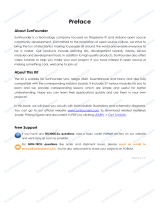
software includes a serial monitor which allows simple textual data to be sent to and from the Arduino
board. The RX and TX LEDs on the board will flash when data is being transmitted via the USB-to-serial
chip and USB connection to the computer (but not for serial communication on pins 0 and 1).
A SoftwareSerial library allows for serial communication on any of the Uno's digital pins.
The ATmega328 also supports I2C (TWI) and SPI communication. The Arduino software includes a Wire
library to simplify use of the I2C bus; see the documentation for details. For SPI communication, use the
SPI library.
Programming
The Arduino Uno can be programmed with the Arduino software (download). Select "Arduino Uno from the
Tools > Board menu (according to the microcontroller on your board). For details, see the reference and
tutorials.
The ATmega328 on the Arduino Uno comes preburned with a bootloader that allows you to upload new
code to it without the use of an external hardware programmer. It communicates using the original STK500
protocol (reference, C header files).
You can also bypass the bootloader and program the microcontroller through the ICSP (In-Circuit Serial
Programming) header; see these instructions for details.
The ATmega8U2 firmware source code is available . The ATmega8U2 is loaded with a DFU bootloader,
which can be activated by connecting the solder jumper on the back of the board (near the map of Italy)
and then resetting the 8U2. You can then use Atmel's FLIP software (Windows) or the DFU programmer
(Mac OS X and Linux) to load a new firmware. Or you can use the ISP header with an external programmer
(overwriting the DFU bootloader). See this user-contributed tutorial for more information.
Automatic (Software) Reset
Rather than requiring a physical press of the reset button before an upload, the Arduino Uno is designed in
a way that allows it to be reset by software running on a connected computer. One of the hardware flow
control lines (DTR) of the ATmega8U2 is connected to the reset line of the ATmega328 via a 100 nanofarad
capacitor. When this line is asserted (taken low), the reset line drops long enough to reset the chip. The
Arduino software uses this capability to allow you to upload code by simply pressing the upload button in
the Arduino environment. This means that the bootloader can have a shorter timeout, as the lowering of
DTR can be well-coordinated with the start of the upload.
This setup has other implications. When the Uno is connected to either a computer running Mac OS X or
Linux, it resets each time a connection is made to it from software (via USB). For the following half-second
or so, the bootloader is running on the Uno. While it is programmed to ignore malformed data (i.e. anything
besides an upload of new code), it will intercept the first few bytes of data sent to the board after a
connection is opened. If a sketch running on the board receives one-time configuration or other data when
it first starts, make sure that the software with which it communicates waits a second after opening the
connection and before sending this data.
The Uno contains a trace that can be cut to disable the auto-reset. The pads on either side of the trace can
be soldered together to re-enable it. It's labeled "RESET-EN". You may also be able to disable the auto-
reset by connecting a 110 ohm resistor from 5V to the reset line; see this forum thread for details.
USB Overcurrent Protection
The Arduino Uno has a resettable polyfuse that protects your computer's USB ports from shorts and
overcurrent. Although most computers provide their own internal protection, the fuse provides an extra
layer of protection. If more than 500 mA is applied to the USB port, the fuse will automatically break the









